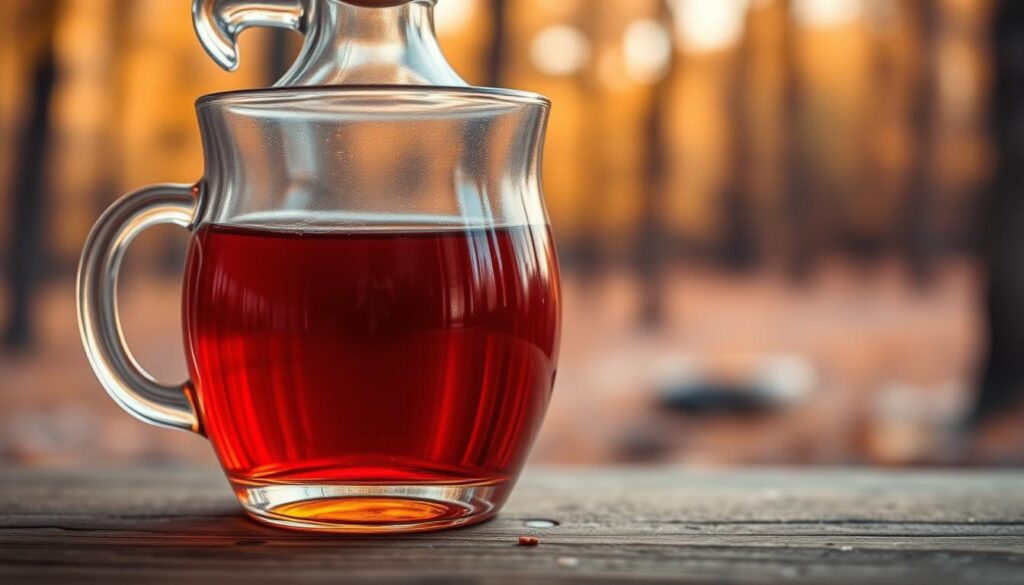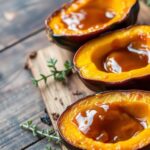Maple syrup’s perfect taste is a mix of art and science. Brix, a key measurement, shows the syrup’s sugar content. It affects the flavor and quality we love. Sugarmakers need to know about brix levels to make syrup that’s both tasty and meets customer expectations.
The best brix levels make every drop of syrup sweet and complex. This creates a wonderful taste experience for everyone.
The journey from sap collection in spring to syrup boiling is key. It starts with harvesting sap from sugar maple trees. The sap must be collected under the right conditions for the best sweetness.
As sap is boiled, the sugar content increases. This is when the syrup’s flavor starts to form. Measuring brix at this stage is important. It tells sugarmakers if they’re getting the syrup’s sugar concentration just right.
Many things affect brix levels, like the environment, tree health, and production methods. Sugarmakers can use this knowledge to improve their syrup-making. This ensures every batch meets quality standards and captures the maple flavor we all enjoy.
This article explores the link between brix levels and syrup quality. It offers insights that deepen your appreciation for maple syrup. By the end, you’ll know how to hit those perfect brix levels for the best maple syrup.
Understanding Maple Syrup Brix
Maple syrup brix shows how much sugar is in the syrup. It’s a key number for both makers and buyers. The brix level affects how sweet the syrup tastes, which is important for quality.
The Role of Brix in Taste Perception
Higher brix means sweeter syrup, which people love. Sugarmakers check these levels to match what buyers want. For more on Canadian maple syrup, this source is great.
Knowing about brix helps sugarmakers make syrup that tastes great. Checking the brix is key to making syrup that’s both good and appealing.
What is Brix Measurement in Maple Syrup?
Brix measurement is key in making maple syrup. It shows how sweet the syrup is and its quality. The brix scale measures sugar content in foods and drinks. For maple syrup, it tells producers how sweet it is, helping them make consistent syrup.
Understanding the Brix Scale
The brix scale measures sugar in liquids. For maple syrup, a 66° Brix reading means it’s ready to bottle. This helps sugarmakers know when to harvest and process the syrup best.
Knowing about brix measurement helps both producers and buyers understand maple syrup quality. It ensures the syrup is sweet, has the right thickness, and stays flavorful over time.
The Importance of Brix Levels for Maple Syrup Quality
Knowing how brix levels affect maple syrup quality is key for both makers and buyers. Brix levels show the syrup’s sugar content. This is vital for how long the syrup stays fresh and tasty.
The role of brix goes beyond taste. It also impacts how well the syrup keeps and stays stable.
Brix and Product Stability
Syrups with the right brix levels are more stable. This means they’re less likely to spoil, turn into crystals, or ferment. More sugar makes it harder for bad bacteria to grow, keeping the syrup fresh longer.
When producers aim for the best brix levels, they help the syrup keep its quality. This is important for making customers happy.
In short, the right brix levels protect the syrup’s flavor and keep it appealing to buyers. Understanding and keeping brix levels in check leads to better syrup quality. It makes the syrup more enjoyable for everyone.
Optimal Maple Syrup Brix for Sweetness and Flavor
For sugarmakers, finding the perfect mix of sweetness and flavor is key. The right brix level in maple syrup is vital. A brix level between 66-68% is ideal, balancing sweetness and flavor well.
Knowing how sugar content affects flavor helps producers make syrup that tastes great. This knowledge helps them meet consumer preferences.
Finding the Perfect Balance
Different brix levels change how maple syrup tastes. Too much sweetness can hide flavors, while too little might not be rich enough. Here’s a table showing how brix levels impact taste:
| Brix Level (%) | Maple Syrup Sweetness Level | Flavor Characteristics |
|---|---|---|
| 64 | Sweet with mild flavor | Subtle, light maple profiles |
| 66 | Balanced sweetness | Rich, well-rounded flavors |
| 68 | Higher sweetness | Robust, deep maple essence |
| 70 | Very sweet | Sugar-forward, possible loss of nuance |
Knowing the best brix levels helps producers focus on the flavors they want. This ensures their syrup meets consumer tastes, making for a great maple syrup experience.
How to Measure Brix in Maple Syrup
Measuring Brix levels in maple syrup is key to knowing its quality and sweetness. Sugarmakers use special tools and methods to get the perfect Brix level, usually between 66° and 67°. Knowing how to measure Brix ensures maple syrup is always top-notch.
Tools and Techniques for Accurate Measurement
For measuring Brix in maple syrup, you need a few tools:
- Refractometer: This handheld device gives fast and accurate sugar concentration readings. It needs a small syrup sample placed on its glass prism.
- Hydrometer: Used in bigger operations, it measures syrup density. It floats in the syrup, showing sugar content based on its depth.
- Digital Brix Meter: For those who want the latest tech, this meter gives quick readings and can save data for later.
To measure right, sugarmakers should remember these tips:
- Clean all tools before use to prevent contamination.
- Measure at the same temperature, as cold syrup can mess up readings.
- Use the Rule of 86 to better understand sap density and sugar content.
Being careful with these tools helps make syrup at its best. It makes the syrup’s quality better.
Factors Influencing Maple Syrup Brix
Many things affect the brix levels of maple syrup, which changes its quality and taste. Knowing these factors helps sugarmakers improve their work. Important factors include weather, tree types, how sap is collected, and how syrup is made.
Environmental and Processing Considerations
Weather and when sap is collected greatly impact syrup’s sugar content. Sap collected later in warmer weather has different sugar levels than early sap. The type of tree also matters, as some trees give sap with more sugar.
How syrup is made is also key. The methods used during boiling can change the syrup’s sweetness. By adjusting to these factors, sugarmakers can make better syrup.
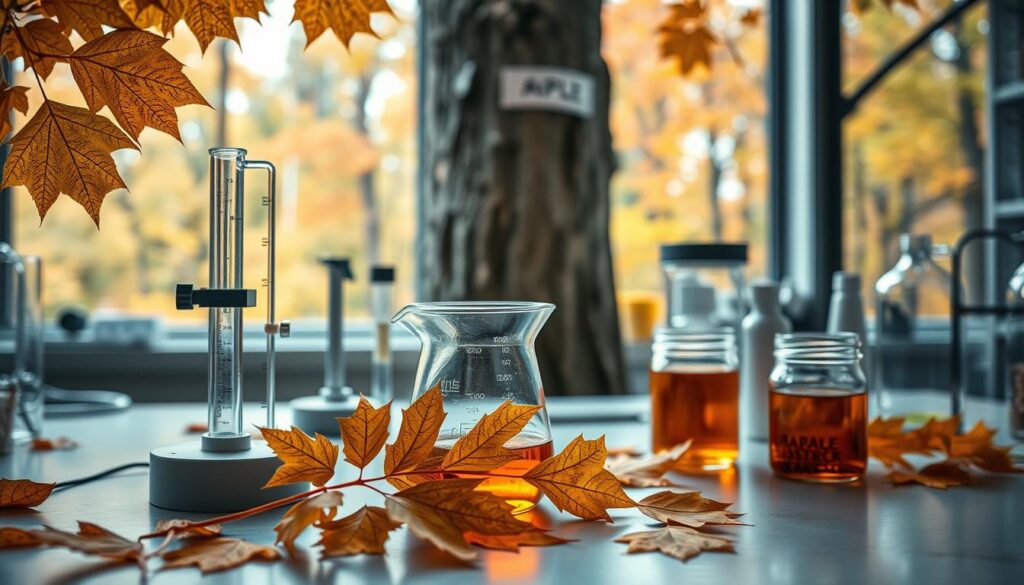
Maple Syrup Grading: How Brix Levels Affect Quality
Maple syrup grading is key to understanding syrup quality. It’s tied to brix levels, which show sugar content. The USDA-approved system sorts syrup into grades based on brix and taste. Knowing this helps buyers pick the right syrup for them.
Grading Systems Explained
Maple syrup grades include Light Amber, Medium Amber, and Dark Amber. These grades show syrup’s brix levels and taste. Syrups with higher brix levels have richer tastes and darker colors, affecting their market value.
| Grade | Brix Levels (%) | Flavor Profile |
|---|---|---|
| Light Amber | 66.0 – 68.9 | Delicate and mild taste |
| Medium Amber | 68.0 – 70.5 | Balanced sweetness with richness |
| Dark Amber | 70.0+ | Strong and robust flavor |
Each syrup grade impacts what consumers choose and market demand. Quality perception changes with these categories. Sugarmakers work to match their syrup with the right grades to meet market and consumer needs.
Best Brix Levels for Maple Syrup Production
Knowing the best brix levels for maple syrup is key to meeting consumer needs. The right brix range greatly affects syrup quality, influencing taste and texture. By focusing on specific brix levels, producers can cater to different markets, improving their products.
Brix measures sugar content in maple syrup, showing its quality and richness. Syrups with a brix of 66-68 degrees are perfect for sweetness and texture. This range meets consumer expectations and keeps the syrup’s natural flavor.
Targeting Consumer Preferences
Market trends shape how sugarmakers produce syrup. Many believe higher sugar content means better taste and quality. So, sugarmakers adjust their methods to meet these expectations.
Understanding consumer behavior helps producers. Some like syrup with lower brix for a milder taste, while others prefer the strong flavor of higher brix syrup. By knowing these preferences, producers can tailor their products to meet demand.
It’s important to stay updated on industry standards. Sugarmakers can learn about the best brix levels from resources on syrup production. Knowing about maple syrup quality helps them make better choices for success in the market.
| Brix Level | Flavor Profile | Consumer Preference |
|---|---|---|
| 64-65 | Mild and Light | Preferred for delicate recipes |
| 66-68 | Rich and Robust | Most popular among consumers |
| 69-72 | Sweet and Thick | Favored for dessert applications |
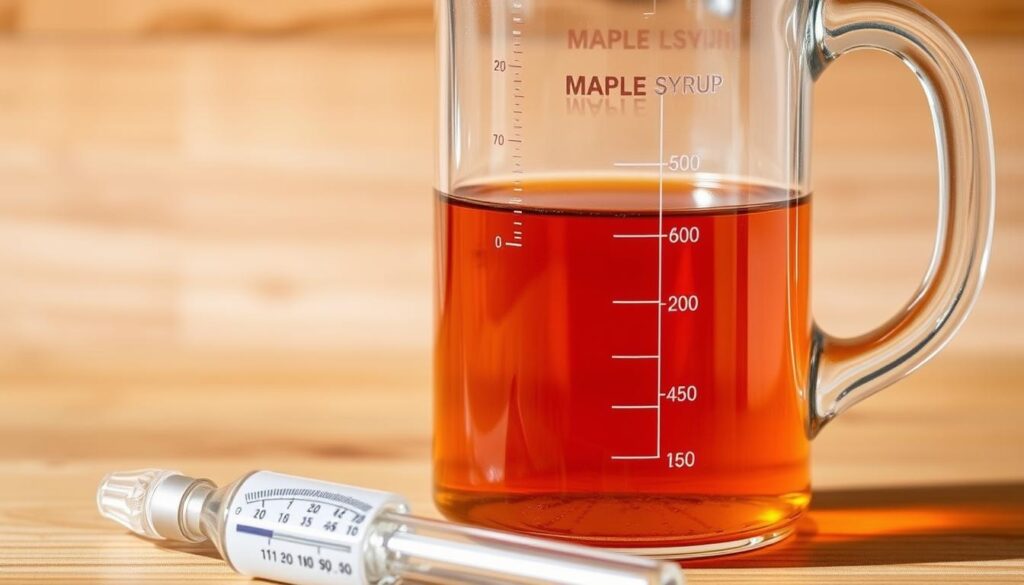
Maple Syrup Sweetness Levels Explained
Understanding maple syrup sweetness involves knowing about different sugars. The sweetness changes with the brix level and syrup composition. The mix of fructose, glucose, and sucrose greatly affects the taste. This is key for both makers and those who enjoy it.
The Spectrum of Sweetness
Maple syrup comes in various sweetness levels. For example, Grade A – GOLDEN has a light taste, while Grade A – DARK is richer. These differences change how we experience the syrup and how we use it in cooking. Knowing the sugar content helps producers meet different tastes and needs.
The type of sugar in syrup matters a lot. Fructose is sweeter than glucose, making each syrup feel different on our tongues. When choosing syrup for cooking, its sugar profile is important. It affects how well it works in recipes, from cakes to pancakes.
Comparing Sugar Content in Maple Syrup
Knowing the different types of sugar in maple syrup helps us understand its quality. Maple syrup mainly has sucrose, glucose, and fructose. These sugars affect both flavor and brix measurement. The right mix of these can make the syrup taste better and please more people.
Types of Sugars and Their Effects
The mix of sugars in maple syrup is key to its quality. Here’s how they break down:
| Type of Sugar | Percentage | Flavor Profile Impact |
|---|---|---|
| Sucrose | Approximately 66% | Provides the primary sweetness |
| Glucose | About 16% | Contributes to flavor depth |
| Fructose | Approximately 18% | Imparts a hint of fruitiness |
As sugarmakers get better at their craft, knowing the role of each sugar is important. A higher brix measurement means sweeter syrup. But, the type of sugar affects how sweet it tastes to us. For more on the health side of these sugars, see this source.
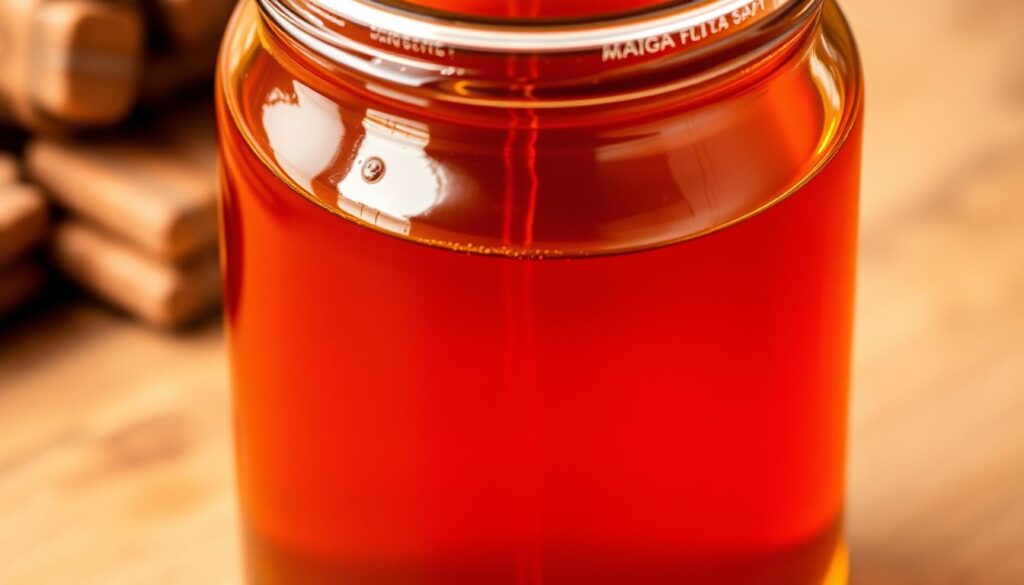
Tips for Achieving Ideal Brix Levels in Maple Syrup
To make top-notch maple syrup, sugarmakers need to use the right methods. They should aim for the perfect brix levels. Knowing the best practices can really help improve the syrup’s taste and sweetness.
It’s important to keep an eye on the weather and use precise tools. This helps a lot in making syrup that’s just right.
Best Practices for Sugarmakers
Having a solid plan is key to getting the sap right. This leads to better syrup with the right brix levels. Here are some important steps:
- Maximizing sap flow: Tap trees when it’s warm during the day but cold at night. This makes the sap move better.
- Regulating evaporation rates: Keep the boiling steady. Boiling at 219°F (104°C) is best for the right sugar content.
- Utilizing accurate measuring tools: Use digital thermometers and hydrometers. They give you the sugar and temperature info you need.
| Maple Syrup Grade | Boiling Temperature Range (°F) | Brix Level (%) |
|---|---|---|
| Golden Color, Delicate Taste | 212-213 | 66-67 |
| Amber Color, Rich Flavor | 214-215 | 66-67 |
| Dark Color, Robust Taste | 216-218 | 66-67 |
Following these tips can make syrup production better. Sugarmakers can also check out boiling temperature guidelines for more tips on syrup quality.
Common Mistakes in Maple Syrup Brix Measurement
Getting the brix measurement right is key to making top-notch maple syrup. Even with good tools, mistakes can happen. Knowing these mistakes helps sugarmakers keep their syrup quality up.
Avoiding Pitfalls in Production
Several things can cause brix readings to be off. Fixing these problems is important for syrup quality. Here are some common errors:
- Temperature fluctuations: Brix readings change with temperature. Make sure the syrup is at the right temperature for accurate measurements.
- Improper tool calibration: Unchecked refractometers give wrong brix readings. Always calibrate your tools as the maker says for correct readings.
- Misunderstanding syrup density: Some think density means sweetness. But knowing the difference is key for syrup flavor.
Knowing these common mistakes helps sugarmakers improve their syrup. Checking their methods often ensures quality syrup for customers.
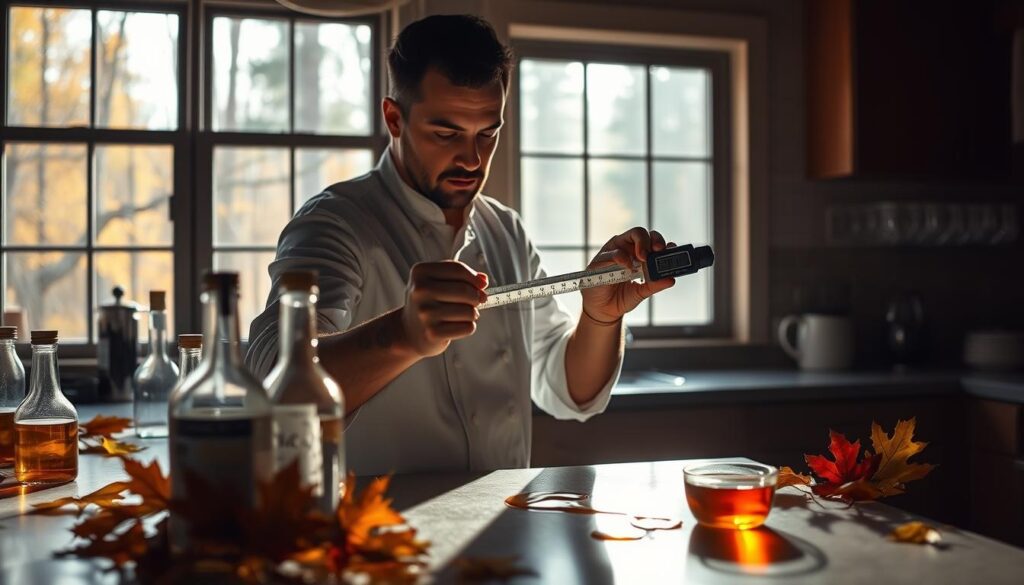
| Mistake | Description | Solution |
|---|---|---|
| Temperature fluctuations | Variances in syrup temperature can skew brix readings. | Measure syrup at a consistent temperature. |
| Improper tool calibration | Using uncalibrated tools results in inaccurate readings. | Regularly calibrate refractometers and other measurement devices. |
| Misunderstanding syrup density | Confusing density levels can lead to inappropriate brix readings. | Study the relationship between density and sweetness for accurate measurements. |
Conclusion
Understanding and keeping an eye on maple syrup brix is key for making top-notch syrup. The link between brix levels and syrup quality is critical for sugarmakers. It affects the syrup’s taste, sweetness, and consistency.
By mastering these details, producers can make syrup that pleases customers. They also show off the skill in making this natural sweetener.
Also, taking steps to keep brix levels right can boost the syrup’s sugar content. Using the best ways to collect sap, boil it, and store it leads to better syrup. It also helps in making maple syrup production more sustainable.
Knowing these things helps makers create syrup that tastes great and is true to its roots.
For those interested in this traditional craft, there are many resources available. They help deepen the understanding of maple syrup as a natural, handmade product. Sugarmakers should keep improving their skills and watch the maple syrup brix. Their hard work shapes the world of this beloved food.

